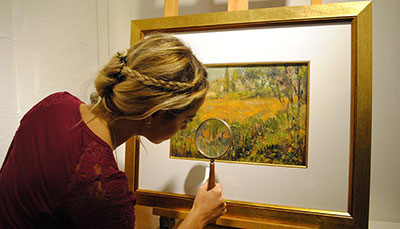featured item

pretty antique edwardian mahogany inlaid music cabinet Read more
PRESENTS FROM THE PAST BOX RIVER NEWS. Your monthly Antiques and Art column from Art Expert, Iain Brunt.
Posted by Trudi on 19/06/2021

The global market for art is worth over $64 billion each year. Is it any wonder therefore that the ability for criminals to pass off works as those of the real artist/maker is also a huge and lucrative industry? Even professional art experts can be taken in - Museums such as New York’s Met Museum and Paris’s Le Louvre have fallen foul of convincing forgeries from sophisticated scammers. In 2018 a museum in southern France, which featured work by acclaimed painter Etienne Terrus, discovered that well over half of its entire collection was in fact comprised of fakes, some of which had artist signatures that simply wiped off when touched
So if the professionals are missing the fakes, what chance do everyday folk have of spotting fakes and forgeries when buying?
Fortunately, the scams to which those esteemed institutions fell foul of were highly complicated and technically accomplished. For the rest of us not buying Grand Master paintings every other day, there are some real tell-tale signs that can be learnt to avoid being burnt.
Firstly, what is an original work of art? Typically, an Original Art is any work considered to be an authentic implementation of the works of an artist, rather than a reproduction or imitation. It’s important to note that an interpretation of an artist’s original art is therefore considered a legal form of art in its own right. So it is artworks purporting to be created by the original artist that are in question here, as opposed to derivative works of the original artist’s work by a second artist.
So, how do we know it was by them and not by another artist copying the work and passing it off as the original artist’s work to cash in on their skill?

There are many books you can refer to in the libraries. The most common one I use is “The Classified Directory of Artists’ Signatures, Symbols and Monograms” by H. H. Caplan published in 1982 by Prior.
Suffolk libraries currently has 2 copies available to refer to, but you can always find one on Amazon ( https://amzn.to/3cYyC1V ). They are not cheap but a great investment for any art investigator.
Let’s talk this week about oil paintings. Generally when you look at an original painting you can see the brush strokes on the canvas and often a few blemishes. If your painting is totally flat then you are probably looking at a print or an imitation reproduction.
If the painting is old it will probably have some discolouration on the surface as to where it has been hanging. Although this sounds crude take a little of your own saliva and gently rub an area of the picture which you don’t mind testing and slowly you should be able to see a different cleaner colour underneath. If you don’t fancy your own saliva try a very, very, small amount of toothpaste but beware, as toothpaste is abrasive and can cause damage if you’re not supremely careful. You often see experts doing this in the auction houses and often they do it over the signature to see if it has been added later or not.
Many forgers added signatures and items to paintings to make them look more like an original artist. There are many versions of John Constable’s famous Hay Wain, but only one original. Look very closely at the subject matter, especially images of cars, machinery or costumes. If you see something that would not have existed in the period it was painted in then beware. Once on a 17th century picture we were researching we saw a very expertly hidden, but definitely there, jet plane in the sky! Someone had added it, probably as a joke, but it made us think who else had touched the painting?
As always, look at the back. A simple tell-tale sign here is to check the frame. Many pictures have labels, some from exhibitions, some from storage and shipping companies, some from the artists themselves. The auction houses used to stamp their stock numbers on the frames so as not to ruin the canvas so this itself can prove age. Nowadays they just add barcode stickers that can be easily removed.
Screw holes in the frames are also a clear signal of their lives. Many holes often mean the frame was used on many other pictures before. You can also see rubbing on the front of the frame where it has been handled many times. These signs are not bad at all as they indicate that the frame has age but it should be the same age as the canvas.
Over the years many pictures have been restored and the only way to do this is to ask an expert restorer. If you have any questions do send us an image to iain@artadvisor.ch so we can try and help.
Iain Brunt
https://www.boxfordsuffolk.com/_files/BRN/2021_07.pdf



